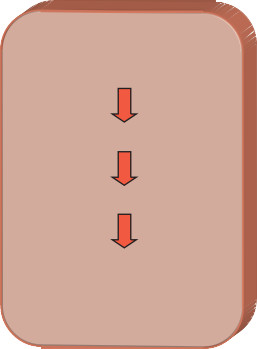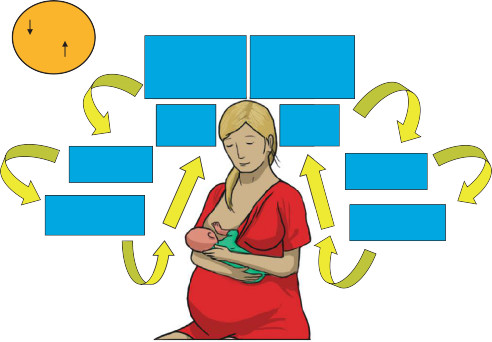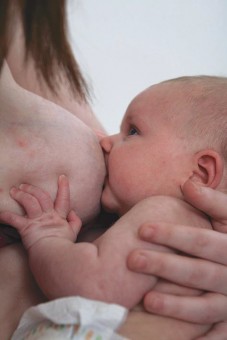Fundamentals of Midwifery: A Textbook for Students (92 page)
Read Fundamentals of Midwifery: A Textbook for Students Online
Authors: Louise Lewis

BOOK: Fundamentals of Midwifery: A Textbook for Students
7.56Mb size Format: txt, pdf, ePub
(a)
Frequent mother—infant contact and proximity + frequent effective suckling and milk removal

(b)
Infrequent, ineffective milk removal
+ mother—infant separation
Pulsatile oxytocin release triggers the milk ejection reflex
Good breast drainage
Prolactin release and copious milk production
Poor milk ejection reflex
Over full breasts
Inhibited prolactin secretion and faltering milk supply

215
Figure 10.2
Recognising (a) optimal and (b) suboptimal hormonal responses and effect on milk production during breastfeeding.
experiences these changes by feeling the breasts increase in size, weight and warmth 48–72 hours after the birth of the baby. This process is often referred to as the ‘milk coming in’.
Lactogenesis III
Lactogenesis III refers to the maintenance of the milk supply which takes place gradually from about 10 days to 6 weeks postnatally. It involves a change from endocrine control to autocrine control within the breast, and is a reflection of the baby’s appetite and its ability to attach well and feed frequently and effectively (Riordan 2010). The effective attachment by the baby ensures the breasts are drained well, thus maintaining a continual supply of milk, which changes accord- ing to the baby’s changing appetite over time. Figure 10.2 illustrates the maternal hormonal responses in response to effective and ineffective milk removal and the effects on milk production.
Prolactin Releasing Factor (PRF)
Prolactin from the anterior pituitary gland (APG) is the hormone responsible for establishing and maintaining effective milk supply. The removal of breastmilk by the suckling baby or expressing increases levels of circulating prolactin; this binds to the walls of the acini cells (lac- tocytes) triggering milk production. Figure 10.3 illustrates the positive feedback mechanism between the mother and the baby. When the breasts are overfull with milk and the alveolar

PIF / FIL
= PRF
Anterior pituitary Gland releases prolactin into blood stream
Posterior pituitary Gland releases oxytocin into bloodstream
Neural pathway
Neural pathway

216
Milk
production Myoepithelial
cells contract
Baby suckling and
milk removal
Milk ejection
Figure 10.3
Summary of the neuroendocrine reflexes involved in effective lactation. Source: Reproduced with permission from J. Green.
walls are stretched, prolactin is unable to attach to the receptor sites and cannot enter the lactocytes, resulting in decreased milk production (Pollard 2012). Skin-to-skin contact and effec- tive frequent breastfeeds in the early postnatal days increases the production of prolactin to prime the prolactin receptor sites. This mechanism is referred to as ‘
opening up the factory
’ to put in the order for milk supply throughout the lactation period, maximising the long-term success of lactation (UNICEF 2008).
Feedback Inhibitor of Lactation
Feedback Inhibitor of Lactation (FIL) locally controls milk synthesis; the specific mechanism is not clear, but it appears to be a compound within the milk. When the milk is not removed, because of reduced breastfeeding, or reduced breast expression, FIL builds up in the milk-filled breasts and slows prolactin secretion from the APG (Riordan 2010). Figure 10.3 illustrates the hormonal control and mechanism of lactation.
Prolactin Inhibitory Factor
Prolactin Inhibitory Factor (PIF) is a hypothalamic trigger which may be related to dopamine or a related substance that builds up and suppresses prolactin secretion from the anterior pituitary gland when breasts are not emptied, decreasing milk production and vice versa (Lawrence and Lawrence 2011).
Prolactin increases milk synthesis and emptying of the breast by the baby suckling or by the use of hand or breast pump expression, enhances plentiful milk production.
Oxytocin is responsible for milk release, enhanced by stimulation of the breast by touch; by sight, smell or cry of the baby and by effective suckling of the baby.
Skin-to-skin
Skin-to-skin contact soon after birth is a natural transition for the mother and baby, facilitating the adaptation from intrauterine to extrauterine life and should be recommended for all mothers, irrespective of their infant feeding choice. Skin-to-skin contact helps by regulating the baby’s heart rate, breathing and establishment of thermoregulation (Anderson et al. 2006; Jonas et al. 2007), whilst also triggering the immune system as the skin bacteria from mother colonises the skin of the baby. Babies are extremely alert and responsive to the mother’s touch and smell soon after birth. Breast odour is a strong stimulus driving the baby towards the nipple, encour- aging neurodevelopment and the baby’s pre-feeding behaviours (Porter and Winberg 1999). The nipple secretions are a similar smell to a substance in amniotic fluid and the baby begins to salivate once he realises food is available.
Skin-to-skin contact promotes bonding between mother and baby and stimulates pulsatile oxytocin secretion in the mother, initiating milk ejection from the cells of acini, facilitating effec- tive milk transfer to the baby when the baby is attached well and suckling effectively. Research has shown that newborns use their hands as well as their mouths to stimulate maternal oxytocin release after birth (Matthiesen et al. 2001). Skin-to-skin contact continues to be beneficial in the postnatal period for mothers and fathers. Figure 10.4 illustrates a mother feeding her baby skin- to-skin in the postnatal period.
Supporting effective infant feeding
The new UNICEF UK Baby Friendly Initiative (BFI) standards for maternity, neonatal, health visit-
ing, children centres and other community services, reflect the latest evidence to support practitioners in providing the best outcomes for mother and babies in the UK (UNICEF 2012a).

Figure 10.4
Skin-to-skin contact in the postnatal period. Source: Reproduced with permission from Philip Batty, www.ibreastfeed.co.uk.

217

Activity 10.3
Read the New UNICEF UK BFI standards and observe how these are implemented in
organisations working towards or maintaining BFI accreditation [Available online] http://www
.unicef.org.uk/Documents/Baby_Friendly/Guidance/Baby_Friendly_guidance_2012. pdf?epslanguage=en
218
Practical skills to support mothers to breastfeed
Other books
Long Road Home by Joann Ross
One of the Guys by Lisa Aldin
Breaking Creed by Alex Kava
To Win Her Trust by Mackenzie Crowne
Dirk Pitt 1 - Pacific Vortex by Cussler, Clive
Revolver by Duane Swierczynski
World War One: A Short History by Norman Stone
Dreams of Leaving by Rupert Thomson
Get It Done When You're Depressed by Julie A. Fast
Twilight by Brendan DuBois